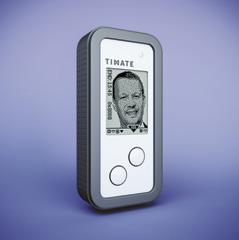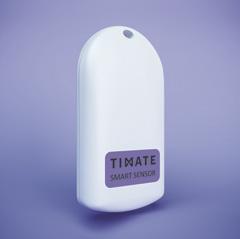
9 minute read
Polish technology takes care of safety at work
Wiktor Doktór, Pro Progressio: Monitoring the health and safety of workers in large workplaces, factories and logistics parks – but also in the service industry – is a challenge known to and faced by companies for many years. Various technological solutions have been developed over time to support occupational health and safety processes. TIMATE was launched a few months ago. What was the basis of the solution you created?
Advertisement
Sebastian Młodziński, CEO of TIMATE: We noticed a niche in the market of working time monitoring tools. Everyone knew when an employee arrived at and left work but no one could tell what the employee was doing at work. We decided to find out – that was our guiding idea. Over time, the system began to develop and evolved from a tool that only measured working time to a solution that strongly supports safety. How? With a TIMATE card, we know if an employee has fallen or fainted. What is more, in the event of an emergency, the employee can also alert his or her supervisor and call for help using the SOS button. In addition, our system reminds the employee to wear a helmet, go for a break as well as supporting evacuation. It is a multidimensional solution which also collects, aggregates and analyses work-related data, hence provides employers with a wealth of information in the form of convenient indicators.
What does all of it involve? What does an employee need to do and what are the duties of the administrator of this solution?
The task of the employee is only to carry the card, which is very important for the functioning of the whole system. Why? Because when the employee does not have the card, the system does not see him or her moving. And a person who is not moving is considered, for example, to have fainted, is lying somewhere and his or her life is in danger. Therefore, from our perspective, it is so important for the employees to carry the card at all times. In order to implement the system, the employer uses the infrastructure that already exists in the company (e.g. a low-voltage network cable or 230V power supply from the camera system) connecting our control panels, which must be located at a maximum distance of 30 metres from one another. We also configure them together with the customer. After that, the system is ready to work. Next, it is necessary to define the employees i.e. to describe what their work involves – whether it is predominantly physical or mental work. Once an employee or groups of employees are defined, the customer analyses these indicators and adjusts them to the reality of the enterprise. This way an employee model the employer wants to strive for is created. Once it is complete, the employer can compare individuals and locations with each other. It happens automatically – just a few clicks and the administrator can find out how the employees work, where they are, if everyone is safe and – in case of evacuation – if everyone has left the building etc. There are many such functions.
Occupational health and safety on the one hand and a number of different functions on the other. What else can you achieve using your technology?
The coronavirus epidemic enabled new areas of application for our system to be noticed. TIMATE locates employees so that the employer can deploy them within the company in a smart way keeping safe distances. It is possible to make sure that people do not gather in certain rooms and areas. Moreover, if employees approach one another less than two metres away, their cards will signal this. We have also added a thermometer option to our card i.e. a sensor that allows body temperature to be measured remotely. Employees can do this on their own but of course, they have to provide their consent in advance. Importantly, we do not collect sensitive data in any of our modules – we do not collect fingerprints, our system has no GPS, we do not track employees, etc. – and it is an absolute
C3 SMART ID CARD – powered with solar energy or a battery, it can function as the employee ID card. C2 SMART ID CARD – thanks to the reinforced silicone case, it is resistant to falls, hits and industrial working conditions.

priority for us but, in the case of the thermometer, we changed our approach. This was forced by the COVID-19 pandemic. In this situation, public welfare is paramount and we count on the employees to agree to such measurements. If the thermometer indicates a tempera ture above 37 degrees Celsius, the cardholder also gets a signal that they should perhaps seek medical attention. It is a matter of personal safety and the safety of other colleagues.
Our system also provides many other functions which optimise work in the company. Using the TIMATE card, the employer can send employees tasks and ‘sees’ when and at what time they were completed. Thanks to the system, the employer can also find and secure dangerous places such as those where falls often occur. It also enables the work of individual employees to be analysed and conclusions to be drawn. In my opinion, data analysis is one of the most important modules of our system – the data itself is worth nothing if we do not analyse it and analysing data helps the entrepreneur to optimise employment. The system shows the efficiency and performance of employees and, consequently, possible savings. The card is a tool that saves a lot of money and allows the best employees to be rewarded.
FULL VERSION OF THIS INTERVIEW IS AVAILABLE ONLY IN PAPER EDITION OF OUTSOURCING&MORE MAGAZINE OR ON THE PRO PROGRESSIO WEBSITE.
C1 SMART SENSOR – the sensor attached to the personal protective equipment.

IoT GATEWAY the main unit generates the MESH radio network connected with the cloud via Ethernet GPRS (data transmission over GSM).

And what about multilocation? Due to the fact that many companies have more than one production site is it possible to monitor the safety of employees in many different locations?
Of course. The system can be operated in different locations. No additional configuration is needed. What is more, we integrate our system with those that already exist in the company. Using the API module we communicate with the software which is implemented at the customer's site. In our business model, you do not pay for the infrastructure but the subscription per employee. We provide the infrastructure and the customer pays only for the use of the system – without any investment costs.

It would seem that this solution serves to ‘monitor’ work. How do company authorities and trade unions view such solutions?
We have been asked if the system does not interfere with the privacy of employees many times. I must reas sure everyone – we do not collect any biometric data. The exception to this is the current emergency situation, where the employer checks the temperature of employees for the benefit of the public’s welfare. Under normal circumstances, however, TIMATE does not collect any sensitive data. The issue of toilets sometimes raises doubts among users, too. Again, I need to emphasise that we do not install control units in the toilets; we do not follow employees to that extent as that is not the purpose of the system. TIMATE does not show the location in centimetres as that is not what this is about. Safety is of the utmost importance. Where does a person feeling unwell go? Usually to the toilet to wash his or her face. It turns out that the bathroom is not only an intimate place but also one where an employee can faint or fall. If they have our card with them, it is possible to help them quickly. It is just a compromise in that the individual is giving up some part of his/her privacy to be safe at work. Some people also ask us if the card emits radiation. Our card emits several hundred times less radiation than a mobile phone and is completely unnoticeable to the human body.
Are only production and logistics companies a group of potential customers of the services offered by TIMATE? Can, for example, large Business Process Outsourcing (BPO) and Shared Services Centres (SSC) also benefit from it?
Entry/exit cards, which usually only inform about the start and end of work, are most often used in BPO/SSC centres. Great emphasis is placed in such companies on appropriate cost optimisation, control of work performance quality and continuous improvement of processes. During large regional operations, overtime often occurs and the company has to pay for work exceeding standard time. TIMATE will be the perfect solution in such a case as our card shows working time to the minute. We can see if the employee has spent 8 hours and 7 minutes or 8 hours and 45 minutes at work and will be paid extra for exactly that time. It sometimes happens in SSC/ BPO centres that overtime is not accounted for accurately mainly due to the fact that working time is not measured precisely. Companies pay “rounded” overtime, even though the employee stayed at the premises of the company for less than 60 minutes. Apart from very accurate settlement of working time, our system provides two-way communication with the em - ployee. The card can be used to provide information about tasks, communicate the most important company messages, and notify about workshops and meetings. I think that such a functionality can also be very useful in this type of companies. The SSC/BPO environment is indeed different from the production environment but TIMATE perfectly supports both these business platforms.
Do similar solutions function in the world or is it rather Polish tech nological thought that is pioneering here?
TIMATE is a system invented by Poles from A to Z; it is also produced in Poland. We were granted a patent in the United States and have also filed patent applications in other countries around the world. No one else but us offers such a solution. There are companies which have been trying to build similar applications using functionalities from different systems but there is no other tool that has so many features and is so affordable. We are pioneers in this field and it is safe to say that our system is revolutionary. What is more, companies have been looking for such a solution, which is why the interest in TIMATE is so enormous today. Thank you for the interview.









